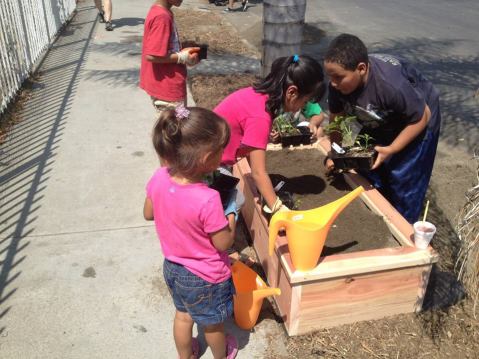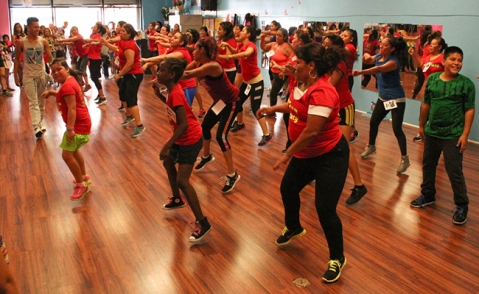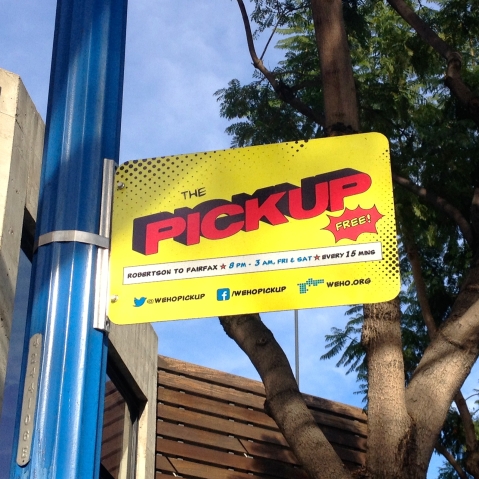LA Waves Parkway Planting Permits to Create Opportunities in Food Deserts
In my last post, I highlighted an innovative program in Toronto which brings a mobile produce market to communities who lack access to affordable and healthy food. In an effort to address healthy food access in similarly underserved neighborhoods across the US, some community residents have literally taken action into their own hands by transforming underutilized and sometimes unlikely patches of land into “guerrilla” gardens.
Trees, wildflowers, herbs, fruits and vegetables pop up in vacant lots, alleys, tree pits and even parkways (the planted strip of land between the curb and the sidewalk), providing aesthetic value, helping to oxygenated the air and clean the soil, as well as providing families with an opportunity for healthy eating. Parkways are often owned by a city but the responsibility for maintenance falls on the adjacent homeowner. These spaces have a lot of potential for urban gardening because they are right outside of a house or apartment building and are a manageable size. Some parkways go ignored, some become planted, and others become community resources.
In 2010, gardener and activist Ron Finley co-founded LA Green Grounds, a group who plants and tends gardens created in parkways and other underutilized spaces with the hope of creating a food and health revolution in underserved South Los Angeles. In 2013, Mr. Finely gave a TED Talk (above) where he discussed the inspiration for the parkway garden he created in front of his home. Mr. Finley, who grew up in South Los Angeles and raised his children there, asked the audience, “…I was wondering, how would you feel if you had no access to healthy food, if every time you walk out your door you see the ill effects that the present food system has on your neighborhood? I see wheelchairs bought and sold like used cars. I see dialysis centers popping up like Starbucks. And I figured, this has to stop. So I figured that the problem is the solution. Food is the problem and food is the solution. Plus I got tired of driving 45 minutes round trip to get an apple that wasn’t impregnated with pesticides.”
Prior to a 2013 amendment to the City’s “Residential Parkway Landscaping Guidelines”, it was illegal to plant fruits and vegetables in parkways, but due to the activism of Mr. Finley and many others, the LA City Council decided to make an exception for vegetable gardening. While this news was a step in the right direction for urban gardeners and community health advocates, the permit to plant anything other than grasses and certain shrubs, still carried a cost-prohibitive $400 price tag. But just this week, the LA City Council voted to waive the $400 fee for parkway gardens (excluding fruit trees). The City Council will still have to define the parameters of the law (regulating garden height and addressing concerns such as safe passage for pedestrians) and the ordinance will be subject to final Mayoral approval, but waiving the fee will be a significant win for advocates and paves the way to increase the opportunity for residents to bring fruits and vegetables in to their neighborhoods without the worry of fines hanging over their heads.
My Finley says: “I have witnessed my garden become a tool for the education, a tool for the transformation of my neighborhood. To change the community, you have to change the composition of the soil. We are the soil. You’d be surprised how kids are affected by this. Gardening is the most therapeutic and defiant act you can do, especially in the inner city. Plus you get strawberries.”
Toronto’s Mobile Market
The Mobile Good Food Market is taking healthy food on the road and providing affordable and nutritious food options in communities that live in food deserts – neighborhoods with little local access to healthy food options.
The bus was the brainchild of FoodShare Toronto which is an organization who works with neighborhoods and schools to provide healthy food options and education. They operate under the notion that “everyone deserves access to affordable high-quality fresh food”.
The bus was designed by LGA Architectural Partners and commissioned by FoodShare Toronto. The wheelchair accessible bus can be boarded to check out the goods and can also protect patrons in inclement weather.
Currently, the bus travels to neighborhoods only two days a week but FoodShare Toronto is hoping to find funding to expand service and provide more opportunities for residents to take advantage of healthy, fresh foods.
This program reminds me of Boston’s City Hall To Go truck which brings city hall services right to your front door. The mobile office travels to different neighborhoods and allows constituents to renew a residential parking permit, get something notarized, request a copy of a birth certificate and more. This service provides easy access to documents and services that may be difficult to obtain because of personal mobility, distance or other issues. It’s exciting to think about what others ways our cities, towns or even rural communities could be transformed through other kinds of mobile services.
Zumba Boom in South LA
South Los Angeles is a 50-square-mile area within the city of LA with a lot of strengths and a lot of challenges. Many residents of this community are underserved, which means in part that they have little access to green space, safe recreational opportunities or healthy and affordable eating options. As a result, many community members struggle with obesity, heart disease and other health-related conditions in percentages disproportionate to other areas of LA with better access to resources conducive to community health. As is the case in many underserved communities, sometimes creative solutions meet opportunity and the results can be transformative.
Zumba, the Latin dance-inspired exercise craze began in Colombia in the 1990’s by Alberto “Beto” Perez. As the popularity of these classes grew internationally, the demand for Zumba teaching certifications also grew, and in response, Perez created a one-day long workshop for aspiring teachers. In the last few years almost 40 Zumba studios have found their way in to unlikely places such as parking lots, beauty parlors, swap meets, and storefronts, allowing residents to take advantage of more conveniently located exercise opportunities creatively housed in their neighborhood.
Eduardo Torijan and his wife Santa opened a studio in South LA five years ago. “We want to see people healthy and well,” he said. “That’s our goal. It’s helping people who are overweight to survive, to combat illness and know that there’s a place here for them.”
Cheeky Transit
The City of West Hollywood is hoping patrons of popular bars and restaurants on Santa Monica Boulevard will ditch the car keys and hop aboard the free, DJ-carrying, pop art-inspired trolley called The Pick Up Line.
The wonderfully outrageous trolley runs along a four-mile stretch of the busy boulevard every Friday and Saturday night and is supported by local businesses who offer passengers discounted appetizers, drinks and other perks.
The Pick Up Line is strategically placed to serve a need but it also excels in making public transportation seriously fun. This innovative combination has led to great success and saw approximately 1,200 passengers coming aboard during the trolley’s first year. So much success in fact that trolley will soon expand service, running on Sunday nights and holidays. The route will also be extended inviting more people to jump aboard and then post their Pick Up Line selfies to Instagram or Facebook.
This isn’t the first time the City of West Hollywood has proven to be an innovator in transportation planning. In 2012, the city temporarily painted one intersection of crosswalks on Santa Monica Boulevard in rainbow colors to celebrate Gay Pride. The crosswalks became so popular that the city decided to keep the rainbow crosswalks which serves to welcome the LGBTQQAAIP community to West Hollywood. Councilmember John Duran said that the crosswalks tell passersby that West Hollywood “is a sanctuary. It tells them there is a safe place in America where the LGBT community is celebrated.” In addition to being welcoming, these brightly-colored crosswalks are a very smart safety feature, which create a clearly defined and protected space for pedestrians who are crossing the busy intersection. Win-win.
Designing for the Vulnerability of the Other: What Love Looks Like in Urban Design
In an essay for The Guardian newspaper after the unfortunate celebrity photo leak of 2014, author Roxane Gay detailed why this sad and criminal act only reinforced an ongoing vulnerability women and other marginalized populations continue to experience in our society. She writes: “…privacy is a privilege. It is rarely enjoyed by women or transgender men and women, queer people or people of color. When you are an Other, you are always in danger of having your body or some other intimate part of yourself exposed in one way or another. A stranger reaches out and touches a pregnant woman’s belly. A man walking down the street offers an opinion on a woman’s appearance or implores her to smile. A group of teenagers driving by as a person of color walks on a sidewalk shout racial slurs, interrupting their quiet.” She continues: “For most people, privacy is little more than an illusion, one we create so we can feel less vulnerable as we move through the world, so we can believe some parts of ourselves are sacred and free from uninvited scrutiny.” She explains that what the hackers did only serves as a reminder to these women that “no matter who they are, they are still women. The are forever vulnerable”.
In a brief and passionate speech (above), actress and activist Laverne Cox discusses her experience being a transgender woman of color and illustrates how intersecting issues of transphobia, racism and misogyny can play out in public spaces. When Ms. Cox shares a past experience with street harassment, she attempts to highlight the precarious position in which she, and other trans women of color can sometimes find themselves. Ms. Cox ends the speech by suggesting that love may be a solution to putting an end to these types of incidences and quotes Cornell West who says “justice is what love looks like in public”.
In recent years, we seem to be hearing an increasing number of stories about violence perpetuated against transgender and gender non-conforming individuals as well as heart-wrenching accounts of young people who feel alone and hopeless and end up taking their own lives. These awful stories from our LGBTQQ community only add to a catalog of other similar stories of public harassment, violence and discrimination against racial and religious minorities. As someone who spends a lot of time thinking about how to create safer public spaces (our streets, parks, plazas and other gathering places), I wonder how these experiences can inform better urban planning, policy and design and how that design might contribute to the safety of our most vulnerable populations.
Existing design guidelines only take us so far. For example, public space design guidelines attempt to promote design strategies that create spaces inclusive of a wide variety of users and modes of transportation, but often fail to address social issues like gentrification. Other guidelines attempt to improve environments for specific reasons (like creating permeable surfaces for water retention or constructing a protected bike lane); or specific populations, often those with physical challenges (like the deaf community who orient themselves through vision and touch or seniors who may have fluctuating levels of mobility). These kinds of recommendations are an exciting addition to the world of urban design but they don’t necessarily address more comprehensive safety issues.
First, I want to take the opportunity to acknowledge my own limitations in discussing this work. I am a white, straight, able-bodied, cis woman, and I recognize that these attributes shape my outlook on the world. Additionally, I understand that my personal experiences, specifically my level of comfort in a public space, are not universal experiences. These statements may seem obvious but it may be less obvious how these attributes influence my professional work and the lens in which I view policy, planning and design initiatives for the general public. Am I humble enough to listen or try to empathize with the stories of our most vulnerable populations? How often do I think about the struggles of those who have dissimilar experiences to my own and how do I begin to create respectful dialogue with the hope of informing better urban design?
Community engagement is an integral part of a successful design process. Engagement can be achieved through strategic outreach like holding public meetings, reaching out to community leaders and taking time to listen to, and collect knowledge from the existing community. But I would also like to suggest that while less effective, design may also be informed through first-hand stories, like the essay and speech above, which are not traditional stories about design. After beginning the community engagement process, conducting research, and thinking more critically and contextually about these issues, how do we then use that information to create more relevant design? It may be helpful to begin by looking at larger issues around safety.
As I’ve previously discussed on this blog, my masters thesis investigated deterrents to bicycling for women in New York City. As this project evolved, my questions revolved much less around cycling and more about women’s relationship to safety in the built environment. While interviewing women and reading literature about perceptions of safety, what became very apparent to me is that there is no such thing as “irrational” fears. For example, a handful of women I spoke with told me that they were afraid to ride a bike because they thought someone in a van could pull up next to them and grab them. While this occurrence may not actually be a frequent event, these women’s fears shouldn’t be invalidated because when we understand the context for these fears, we recognize that they represent a larger issue about perceptions of safety that have been informed by personal experience. Instead of dismissing these concerns, we could ask ourselves what elements of urban design could contribute to someone feeling less likely that something like this would happen?
In the survey I conducted, the number one deterrent to bicycling for women was riding a bike a night. Some existing literature suggests that women are less likely to ride bikes because they are naturally more risk averse, but I would argue that it’s more likely that negative past experiences and particular circumstances (like traveling with children) make some women less willing to be alone in environments where they are uncertain of their surroundings. So how can we create a safer experience for these women if they choose to ride a bike at night at some point in the future? Well, we know that lighting, visibility and location are some of the factors that can contribute to safer streets and public spaces, so using our previous example, it would not be necessary to design bicycle lane infrastructure that specifically prevents vans from pulling up and grabbing a cyclist off the street, but if we installed a bike lane on a well-lit street with a lot of visibility and foot traffic, we could create a safer environment for riding a bike and in doing so, limit a myriad of other potential safety concerns.
It may seem like an endless task to try to identify and document an unknowable number of negative experiences and fears a person may have in our public spaces but I don’t think that’s the point. What if instead, we try to think of one person who is the embodiment of the vulnerability of the Other: someone who has some of the largest physical and social challenges in our society? Maybe by imagining that person in our public spaces, we can inadvertently address the needs and fears of a larger cross-section of users and in doing so, create some of the safest, most well used public spaces possible. What would that person look like? Who would they be?
For this purpose, I’d like to try and incorporate some of our earlier examples and suggest that we think of “Joy”, an elderly, black, deaf, transgender woman in a wheelchair. How could Joy more easily traverse a busy boulevard, enjoy a sunny day at the park alone or gather with friends in a public plaza? Through design, how can we make Joy feel safe, provide her with easy accessibility and create a space in which she feels comfortable enough to want to spend time there? What would these spaces look like?
Even if we don’t know someone like Joy, she represents some of the voices that should be at the table. Wondering how Joy may interact with public spaces allows practitioners to create environments that contribute to the safety of other underrepresented individuals. Ultimately, we can’t guarantee that our streets, parks, plazas and other public spaces will be able attract with widest spectrum of users, but by attempting to serve the needs of the Other, at least we can say that we tried. Designing public spaces in this way is what love looks like in design.









